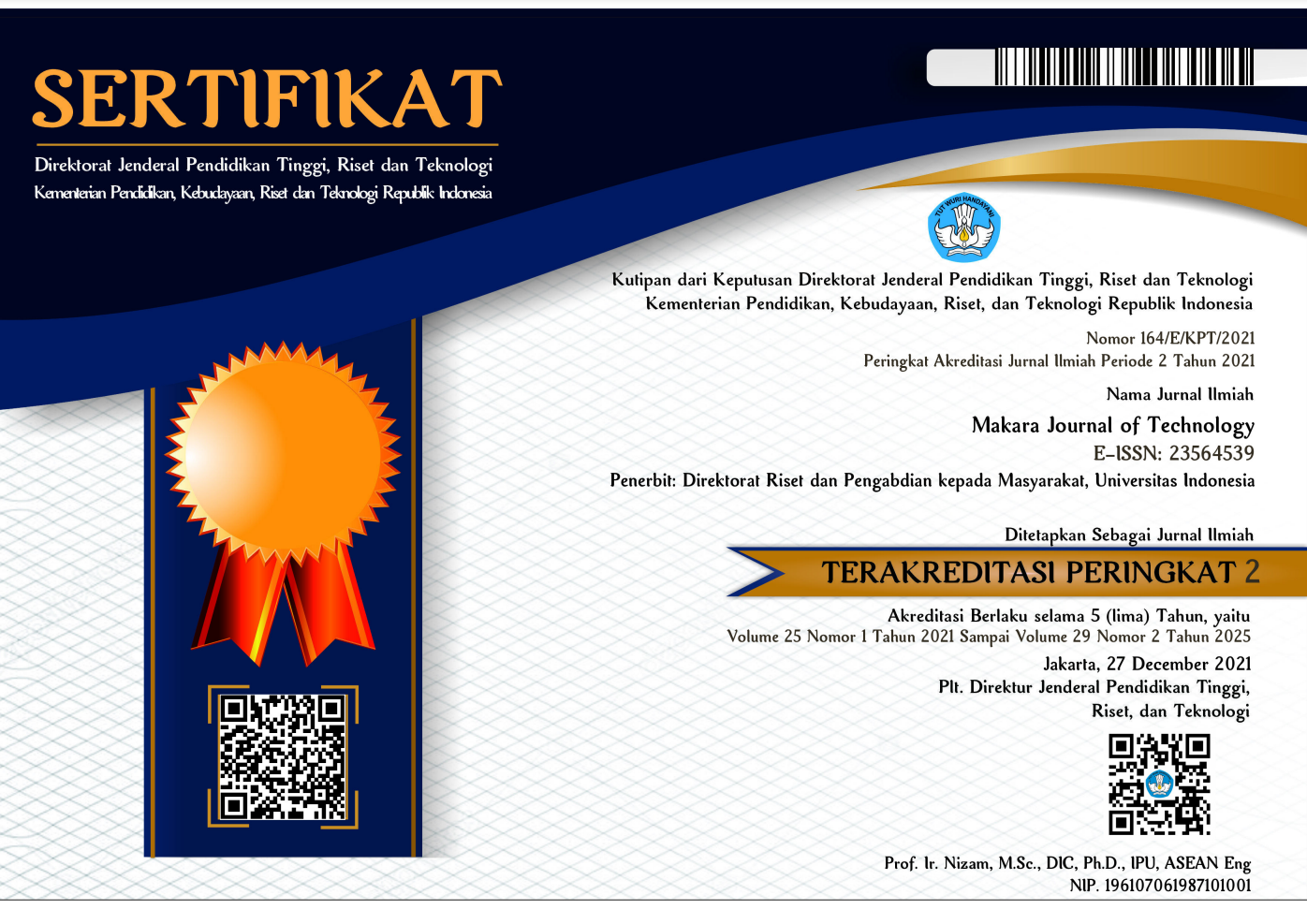Abstract
Marine oil spills are effectively controlled by chemical dispersants. However, the toxicity associated with it reduce its employment in marine environment. To overcome this limitation, the acute toxicity of choline based ionic liquids was evaluated as a potential low toxic variant for oil spill remediation. Further, the aggregation behavior of the individual as well as their binary mixtures was also evaluated by employing tensiometry technique. The half-lethal concentration, LC50on zebrafish (Danio rerio) of three choline based ionic liquids showed that the studied ionic liquids (ILs) fall in the range of “practically nontoxic” ( 100-1000 mg L-1).Various micellar properties showed that a synergistic interaction existed between all the binary mixtures (β < 0, f1and f2
Bahasa Abstract
Uji Toksisitas Akut dari Ionic Liquids (IL) Berbasis Kolin terhadap Ikan Danio rerio dan Perilaku Agresi dari Campuran Binernya. Tumpahan minyak bumi di laut diatasi secara efektif dengan dispersan yang berasal dari bahan kimia. Namun, karena toksisitas yang ditimbulkan oleh dispersan tersebut, penggunaan dispersan tersebut dikurangi dalam lingkungan laut. Untuk mengatasi keterbatasan ini, uji toksisitas akut dari ionic liquid (IL) berbasis kolin dievaluasi sebagai potensial toksik varian rendah untuk remediasi tumpahan minyak bumi. Selanjutnya, perilaku agregasi individu serta cempuran binernya juga dievaluasi menggunakan teknik tensiometri. LC50 dari zebrafish (Danio rerio) untuk tiga IL berbasis kolin menunjukkan bahwa cairan yang diteliti berada dalam kisaran “tidak beracun” (100–1000 mgL-1). Sifat-sifat micellar menunjukkan bahwa interaksi sinergis terdapat pada semua campuran biner (β < 0, f1and f2
References
- Z.H. Asadov, A.H. Tantawy, I.A. Zarbaliyeva, R.A. Rahimov, Egypt. J. Pet. 22 (2013) 261.
- H. Chapman, K. Purnell, R.J. Law, M.F. Kirby, Mar. Pollut. Bull. 54 (2007) 827.
- R. Almeda, C. Hyatt, E.J. Buskey, Ecotoxicology Environ Saf. 106 (2014) 76.
- E. Nyankson, M.J. DeCuir, R.B. Gupta, ACS Sustain. Chem. Eng. 3 (2015) 920.
- R. Maier, G. Soberon-Chavez, Appl. Microbiol. Biotechnol. 54 (2000) 625.
- M.U.H. Shah, M. Sivapragasam, M. Moniruzzaman, M.M.R. Talukder, S.B. Yusup, M. Goto, Biochem. Eng. J. 127 (2017) 60.
- A.M. Atta, H.A. Al-Lohedan, M.M. Abdullah, S.M. ElSaeed, J. Ind. Eng. Chem. 33 (2016) 122.
- M.U.H. Shah, M. Moniruzzaman, M. Sivapragasam, M.M.R. Talukder, S.B. Yusup, M. Goto, J. Mol. Liq. 280 (2019) 111.
- B.L. Gadilohar, G.S. Shankarling, J. Mol. Liq. 227 (2017) 234.
- M.U.H. Shah, M. Sivapragasam, M. Moniruzzaman, M.M.R. Talukder, S.B. Yusup, M. Goto, J. Mol. Liq. 266 (2018) 568.
- J. Aburto, D.M. Márquez, J.C. Navarro, R. Martínez-Palou, Tenside Surfactants Deterg. 51 (2014) 313.
- M.U.H. Shah, M. Sivapragasam, M. Moniruzzaman, M.M.R. Talukder, S.B. Yusup, Mater. Today Proc. 5 (2018) 21661.
- H. Niedermeyer, J.P. Hallett, I.J. Villar-Garcia, P.A. Hunt, T. Welton, Chem. Soc. Rev. 41 (2012) 7780.
- M. Petkovic, J.L. Ferguson, H.N. Gunaratne, R. Ferreira, M.C. Leitao, K.R. Seddon, L.P.N. Rebelo, C.S. Pereira, Green Chem. 12 (2010) 643.
- OECD-203 (Ed.), Fish acute toxicity test, in: Organisation for Economic Co-operation and Development, OECD Guidelines for Testing Chemicals, No. 203, 1992.
- S.H. Baharuddin, N.A. Mustahil, A.A. Abdullah, M. Sivapragasam, M. Moniruzzaman, Proc. Eng. 148 (2016) 401.
- D.R. Passino, S.B. Smith, Environ. Toxicol. Chem. 6 (1987) 901.
- C. Pretti, C. Chiappe, D. Pieraccini, M. Gregori, F. Abramo, G. Monni, L. Intorre, Green Chem. 8 (2006) 238.
- R. Klein, D. Touraud, W. Kunz, Green Chem. 10 (2008) 433.
- D. Rengstl, B. Kraus, M. Van Vorst, G.D. Elliott, W. Kunz, Colloids Surf. B-Biointerfaces, 123 (2014) 575.
- G.B. Ray, I. Chakraborty, S. Ghosh, S.P. Moulik, Colloid Polym. Sci. 285 (2007) 457.
- J.H. Clint, J. Chem. Soc. 71 (1975) 1327.
- P. Holland, D. Rubingh, J. Phys. Chem. 87 (1983) 1984.
- N. Azum, A.Z. Naqvi, M. Akram, J. Colloid Interface Sci. 328 (2008) 429.
- A. Ali, U. Farooq, S. Uzair, R. Patel, J. Mol. Liq. 223 (2016) 589.
- D.N. Rubingh, Solut. Chem. Surfactants, Springer, 1979, p. 337.
- K. Tsubone, Y. Arakawa, M.J. Rosen, J. Colloid Interface Sci. 262 (2003) 516.
- N. Azum, M.A. Rub, A.M. Asiri, A.A.P. Khan, A. Khan, S.B. Khan, M.M. Rahman, A.O. Al-Youbi, J. Solut. Chem. 42 (2013) 1532.
- R. Sharma, S. Mahajan, R.K. Mahajan, Colloids Surf. A-Physicochem. Eng. Asp. 427 (2013) 62.
Recommended Citation
Shah, Mansoor Ul Hassan; Nasruddin, Nasruddin; Yusup, Suzana Bt; and Moniruzzaman, Muhammad
(2019)
"Acute Toxicitystudy of Choline Based Ionic Liquids Towards Danio rerio fish and the Aggregation Behavior of Their Binary Mixtures,"
Makara Journal of Technology: Vol. 23:
Iss.
3, Article 6.
DOI: 10.7454/mst.v23i3.3858
Available at:
https://scholarhub.ui.ac.id/mjt/vol23/iss3/6
Included in
Chemical Engineering Commons, Civil Engineering Commons, Computer Engineering Commons, Electrical and Electronics Commons, Metallurgy Commons, Ocean Engineering Commons, Structural Engineering Commons




